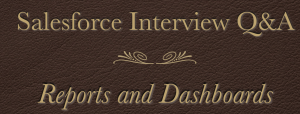Salesforce administrator interview questions – Reports & Dashboards
1.What are different kinds of reports?
There are three types of reports in salesforce.com they are
- Tabular reports.
- Summary reports.
- Matrix reports
2.What are Standard Reports?
Standard reports in salesforce are those provided by salesforce.com. These type of reports can not be deleted and used primarily for creating custom reports.
3.What are custom Reports?
Custom reports in salesforce are those created by user with specific criteria. These type of report can be deleted, edited and stores in personal folders.
4.What is a Tabular report ?
Tabular reports in salesforce are those where the data is displayed in the form of list. In Tabular reports custom data is arranged with out subtotals.
5.What is a Summary Report?
Summary reports in salesforce are those where the data is displayed in the form of summary format. Sorting, sum-total of data can be available in this report.
6.What is a Matrix Report?
Matrix reports is salesforce are those where the data is arranged in grid format having rows and columns. Data is arranged vertically and horizontally in tables like excel format.
7.What is Trend Report?
Trend reports in salesforce are those which displays historical data. Trend reports are used to analyse which fields contains data that we want to leave out.
8.What are Custom Report Types?
Custom report types in salesforce allows us to build framework in the report wizard when creating custom reports. This custom reports can be created between standard and custom objects.
9.Who can run Reports?
In Salesforce.com, most reports run automatically when we click on the report name. If we want to run a report click on “Run Report” to run automatically.

10.What is a bucket field in reports?
In salesforce reports, bucket fields are used to categorize reports records . When we use bucket field in reports there is no need of creating formula or a custom field.
11.Is it possible to delete reports using Data loader?
No, it is not possible to delete reports using data loaders.
12.What are Dashboards?
Salesforce Dashboards are the graphical representation and visual presentation of reports data in salesforce.
13.What are the different Dashboard Components?
Salesforce dashboard components are used to represent data. Salesforce dashboards have some visual representation components like graphs, charts, gauges, tables, metrics and visualforce pages. We can use up to 20 components in single dashboard.
14.What are dynamic Dashboards?
Dynamic dashboards in Salesforce displays set of metrics that we want across all levels of your organization. Enterprise Editions can use five dynamic dashboards and Unlimited edition can use ten dashboards.
Read more on Dynamics dashboards : https://www.salesforcetutorial.com/creating-dynamic-dashboards-salesforce/
15.Can we schedule dynamic dashboards?
No, we can not schedule dynamic dashboards for refresh. It must be done manually.
16.Explain dynamic Dashboard.
Dynamic dashboards in Salesforce displays set of metrics that we want across all levels of your organization.
Dynamic Dashboards in salesforce are Created to provide security settings for the dashboards in salesforce.com. We may have a requirement in an organization to “view all data” by every user in an organization according to their access we have to select Run as Logged-in User. There are two setting option in Dashboards. They are
- Run as specified User.
- Run as Logged-in User.
17.Who can access “drag and drop dashboard”?
User who have permissions in managed dashboard can access drag and drop dashboard.
18.Which type of report can be used for dashboard components?
Summary reports and Matrix reports are used for dashboard components.
19.Which permission is required to set the running user other than you in dashboard?
The user must have “View All Data” permission is required to set the running users.
20.What is the use of “floating report header”?
Floating report headers enables us to display the column header visible on each page when we scroll the report page.
21.How to enable “floating report header”?
To enable floating report header in salesforce go to Setup=>Customize=>Reports and Dashboards=>User Interface settings=>Click on enable floating report header.
22.What is Analytical Snapshot in Salesforce.com ?
Analytical Snapshot in Salesforce are used to create reports on historical data.